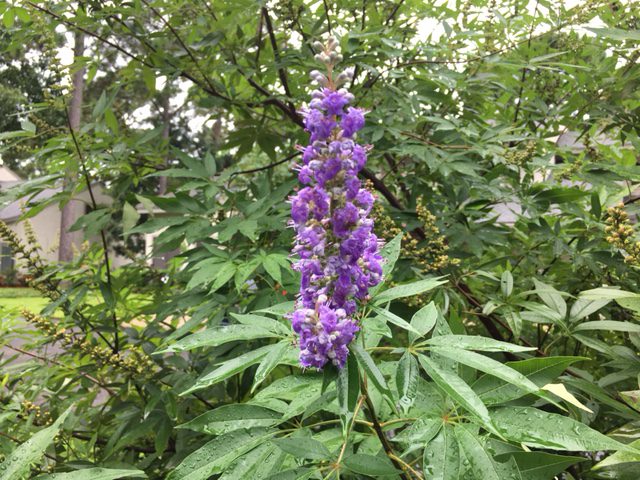
by Sheila Dunning | Aug 26, 2021
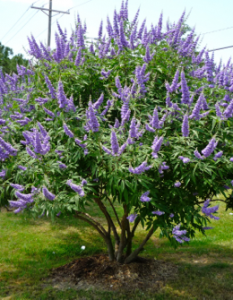
Photos by Sheila Dunning
The showy chaste tree makes an attractive specimen as the centerpiece of your landscape bed or in a large container on the deck. Much more of them are being seen since the Florida Department of Transportation has recognized the tree as a desirable median planting. Easy-to-grow, drought resistant, and attractive to butterflies and bees, Vitex agnus-castus is a multi-stemmed small tree with fragrant, upwardly-pointing lavender blooms and gray-green foliage. The chaste tree’s palmately divided leaves resemble those of the marijuana (Cannabis sativa) plant; its flowers can be mistaken for butterfly bush (Buddleia sp.); and the dry, darkened drupes can be used for seasoning, similar to black pepper, making it a conversation piece for those unfamiliar with the tree.
Vitex , with its sage-scented leaves that were once believed to have a sedative effect, has the common name “Chastetree” since Athenian women used the leaves in their beds to keep themselves chaste during the feasts of Ceres, a Roman festival held on April 12. In modern times, the tree is more often planted where beekeepers visit in order to promote excellent honey production or simply included in the landscape for the enjoyment of its showy, summer display of violet panicles.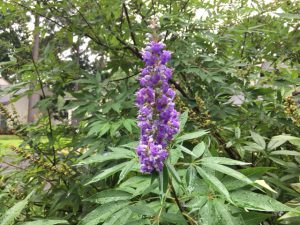
Chaste tree is native to woodlands and dry areas of southern Europe and western Asia. It will thrive in almost any soil that has good drainage, prefers full sun or light shade, and can even tolerate moderate salt air. Vitex is a sprawling plant that grows 10-20 feet high and wide, that looks best unpruned. If pruning is desired to control the size, it should be done in the winter, since it is a deciduous tree and the blooms form on new wood. The chaste tree can take care of itself, but can be pushed to faster growth with light applications of fertilizer in spring and early summer and by mulching around the plant. There are no pests of major concern associated with this species, but, root rot can cause decline in soils that are kept too moist.
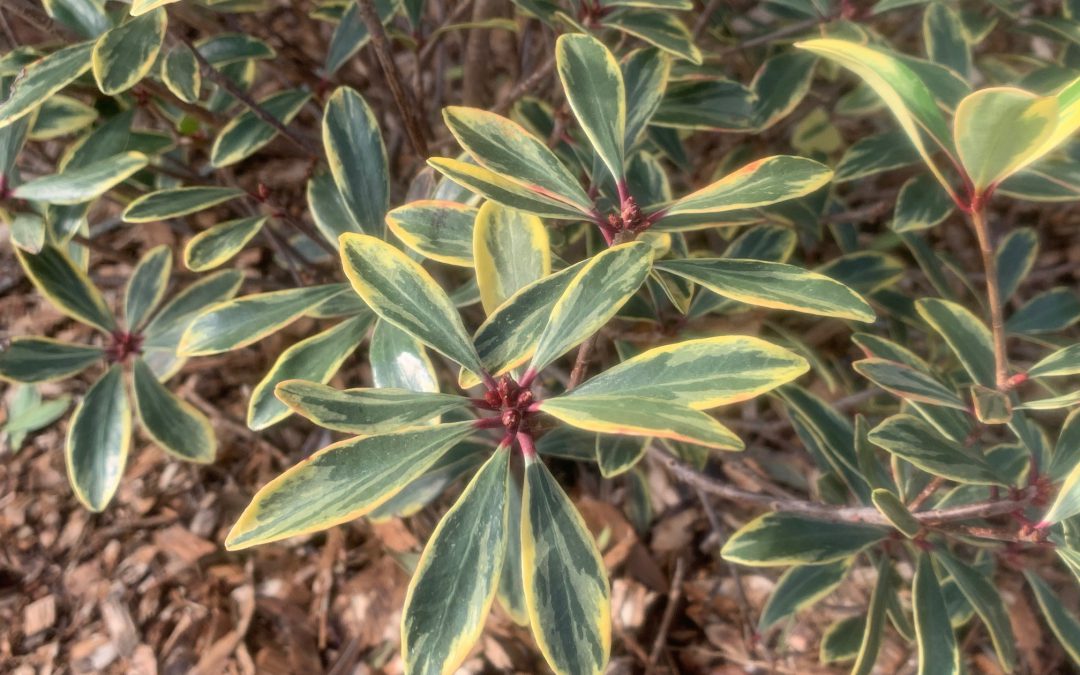
by Beth Bolles | Mar 18, 2021
Plants with variegated foliage are very popular landscape selections. As flowers fade on other plants, the colors of variegated foliage continue to add interest through multiple seasons.
A very adaptable shrub that has been around for a long time, now has a selection with beautiful variegated foliage. Juliet™ cleyera offers green and white evergreen foliage that can brighten up a garden year around. New foliage adds additional interest with a maroon tinge.
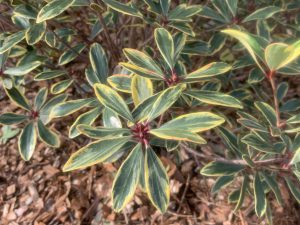
Variegated foliage of Juliet™ cleyera. Photo by Beth Bolles, UF IFAS Extension Escambia County
Like other selections of Cleyera, Juliet™ needs to be matched to an appropriate spot to accommodate its mature size. Shrubs will reach about 8 feet in height with a spread of about 5 feet. Plants may look best when left to grow in a more natural form with light selective pruning. This shrub is probably not suited for planting in front of home windows but used as a specimen or as a nice screen plant.
Once established, cleyera is a low maintenance plant and is adapted to grow well without routine irrigation. My home landscape has very well drained soil and I have not needed to apply supplemental irrigation to two cleyera shrubs in over 20 years. Consider a spot that receives full sun or partial shade for your plants.
An added advantage of cleyera shrubs in general is that bees are attracted to the flowers so it makes an additional nectar source for pollinators in the spring.
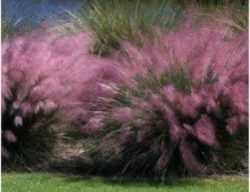
by Sheila Dunning | Feb 18, 2021
The term “ornamental grass” is a catch-all phrase used to describe grasses and “grass-like” plants. Individual species are adapted to a wide variety of landscape sites (i.e., wet or dry, sun or shade, hot or cold climates, and varied salt tolerance). Growth habits range from low ground covers to intermediate shrub-like plants to very tall hedge-like plants. Ornamental grasses are very dynamic; the size, shape, texture, and color of grass changes with every season.
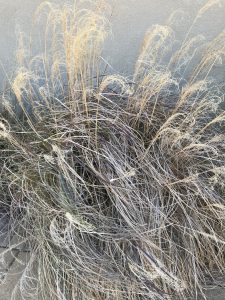
Deciduous Ornamental Grass
Grasses with foliage that dies in the winter and remains dormant until the weather warms in the spring are considered deciduous. The winter character of deciduous ornamental grasses adds tremendous interest to the winter garden when contrasted with evergreen plants or structures such as walls or fences. The dried foliage of deciduous grasses creates sound as it expands and contracts in response to changes in temperature or moisture, while interaction with wind creates movement in the garden. For these reasons, pruning of the dead foliage and inflorescences is not recommended at the time of the first frost.
Pruning of ornamental grasses should be done in late winter or early spring, just prior to new shoot growth. In Northwest Florida, gardeners should target the end of February to prune ornamental grasses. For deciduous grasses, such as Japanese silver grass (Miscanthus sinensis), the old foliage may be completely removed within inches of the soil. Be cautious to not remove the growth point by leaving the grass clump at least 4 inches high. For evergreen grasses, such as muhly grass (Muhlenbergia capillaris), the ragged leaves can be removed to neaten the appearance of the plant without shortening all the way to the ground. So, depending on the damaged portions, the remaining grass clump can be 6-18 inches high after pruning. Grasses recover quickly from a heavier pruning. Within a few months the plant will have completely regrown. If desired, old flower stalks and seed heads may be removed any time they no longer have a neat appearance. For more information on ornamental grass species and growing tips, please visit the EDIS Publication: Considerations for Selection and Use of Ornamental Grasses.
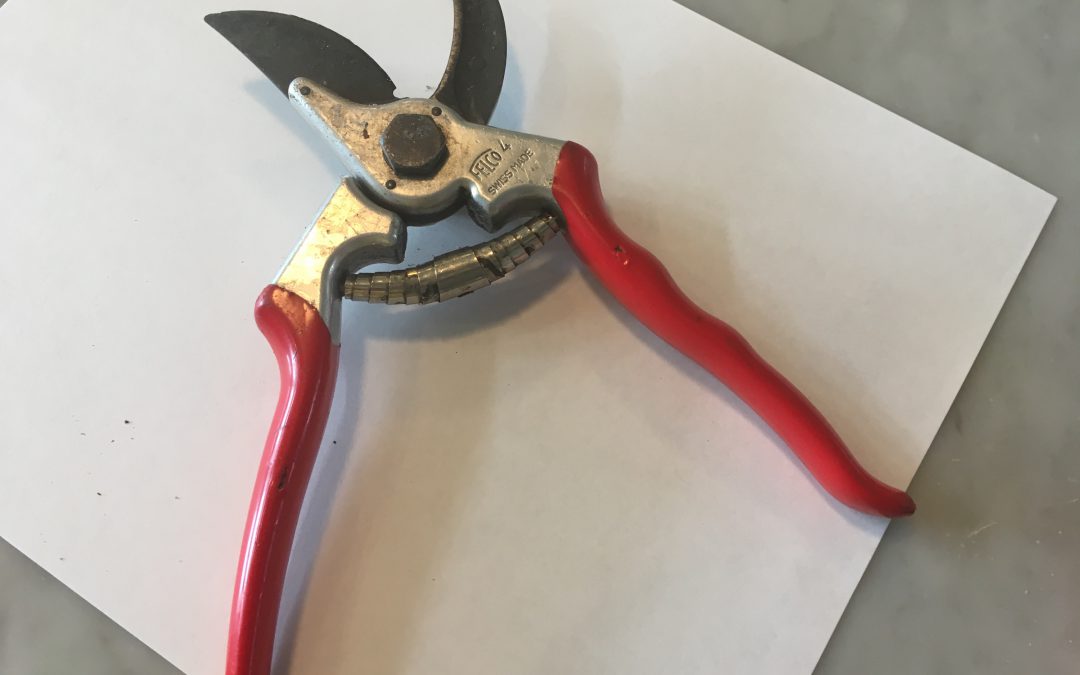
by Daniel J. Leonard | Feb 2, 2021
There is an old saying that rings true in pretty much any situation – “You get what you pay for.” Gardening tools, especially pruners, are no exception. We’ve all been there, fumbling around with a pair of rusty, dull, cheap garden pruners that just barely get the job done. Unfortunately, they can also do considerable harm to the plants you’re trying to improve, as anything short of a nice, sharp, clean cut introduces the potential for insect/disease infestation and will produce a wound that takes much longer to heal, if it ever heals properly at all. You wouldn’t want your doctor to start hacking away at you with a dirty, second-rate scalpel. Don’t subject your plants to the same treatment! While I’m not advocating blowing hundreds or thousands of dollars outfitting your garden tool shed with top of the line everything, investing in a pair of quality bypass hand pruners will pay dividends many years into the future and make your gardening experience much more enjoyable!
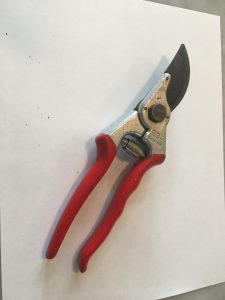
The classic Felco #4 bypass hand pruners. Photo courtesy of Walton County Master Gardener Andrea Schnapp.
Found in three designs, from old-fashioned anvil pruners that smush and smash their way to a cut, to ratcheting pruners that make short work of larger branches but tend to be cumbersome and complicated, to bypass pruners that produce clean cuts in a scissor-like manner, hand pruners accomplish many tasks in the landscape. From cutting small limbs, to harvesting vegetables, to deadheading annual flowers and everything in between, there isn’t a more frequently used, versatile tool. Therefore, it makes sense to buy a quality pair that will perform excellently, still be snipping long after your pruning days are over (if you take care of them), and that are comfortable enough you will enjoy using them. When shopping for your pair of “forever” pruners, there are a few things to look for.
- Only use bypass style pruners. Your plants will appreciate it.
- Look for heavy duty pruners with frames made from quality aluminum or stainless steel; they won’t rust and won’t easily bend or break.
- Buy pruners with replaceable parts. This is especially key because springs eventually rust and gum up and blades break and will eventually lose their ability to hold an edge over time (though you can and should resharpen them).
There are two commonly found brands that fit all three above criteria, albeit at different price points. For a high quality “budget” blade, various models from Corona do an excellent job for the money ($20-30) and won’t hurt your feelings too badly if you happen to lose a pair. Should you decide to splurge a little, Felco makes sharp, indestructible pruners, in multiple models around $50 to fit all size hands. Felco has become the horticulture industry standard and you’d be hard pressed to find a nursery owner or landscaper that didn’t own a pair (or two).
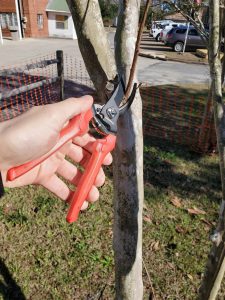
Corona ComfortGel bypass hand pruner. Photo courtesy of Daniel Leonard.
Regardless of which brand you buy (and there are many more than the two above listed) a pair of well-made pruners, if taken care of, should last a lifetime and make your gardening experience much more enjoyable for you and your plants! If you have any questions about gardening tools or equipment or any other horticulture or agronomic topic, feel free to contact your local UF/IFAS Extension Office. Happy Gardening!
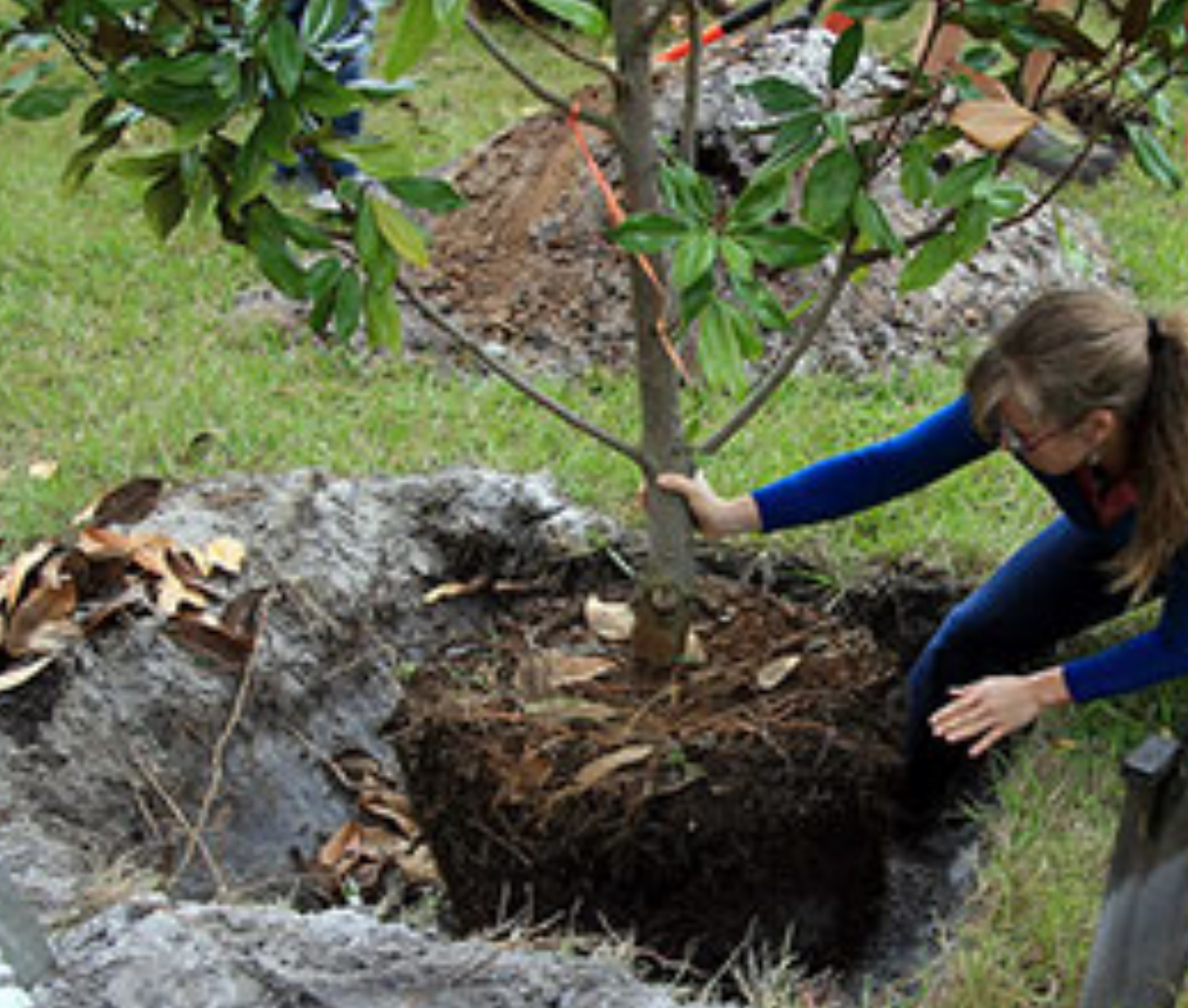
by Daniel J. Leonard | Dec 9, 2020
The last several weeks have brought consistently cool weather to the Panhandle, with a few downright cold nights dipping well below freezing. Though winter isn’t officially here, that won’t happen until December 21st, grass mowing season is definitely over and, if you’re like me and didn’t cover your raised bed garden on those nippy nights, vegetable growing has also slowed significantly. So, what are us horticulturally minded folks with cold-weather cabin fever to do? It’s time to take advantage of sweat-free temperatures, break out the shovels and pruners, and get to work in the landscape!
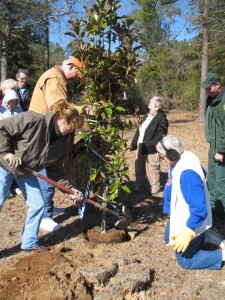
Master Gardeners demonstrate correct tree planting techniques.
The months of December through February are ideal times for planting new trees and shrubs. The reasons for this are simple. Days are short, rain tends to be plentiful, temperatures are cool, and plants are mostly dormant. While newly installed plants need water to become established regardless of when they are planted, demand for supplemental irrigation is significantly less in winter (one of our rainiest seasons) and the chances of a new planting dying from thirst is slim relative to warmer months. Also, planting in winter gives trees and shrubs several months of above ground dormancy to focus their resources below ground, recover from the shock of transitioning from a nursery container into your native soil, and produce valuable roots that will help it get through its first summer. Think about it. Would it be easier for you to start and finish a major outdoor project in July with one bottle of water to drink or in December with an ice chest full? Plants prefer the same!
Not only is winter perfect for planting, tis the season for pruning many species too, deciduous trees (those that lose their leaves in the fall) in particular! The first reason to prune these species in the winter is to give the plants several months to begin healing before growth resumes in spring and insect and disease pressure ramps up again. Many serious pests and diseases of trees are most active during warm, wet weather and all of them have easier access to attack trees through open wounds. Prune in winter to help avoid unwanted pest and disease infestations. Also, dormancy has conveniently knocked the leaves off deciduous species’ branches, allowing us a clear view of the tree’s crown and giving us the ability to make clear, clean, strategic pruning cuts. Proper pruning can help maintain a strong central leader that produces a stately, straight tree and remove dead and diseased branches that could cause problems in the future.
While planting in the winter is always ideal and we just outlined several reasons pruning now can be good, not all plants should be pruned when dormant. For instance, old-fashioned hydrangeas and azaleas that produce blooms from the previous season’s growth. Pruning these in the winter removes all the flower buds that would have bloomed the next summer and what’s the point of an azalea or hydrangea that doesn’t bloom? Also, many small trees and shrubs, like Crape Myrtle and Vitex, may never need pruning if you site them where they will have room to mature without encroaching on other plants or structures.
If you have any questions about planting trees and shrubs, what, when, and how to prune, or any other horticultural topic, please contact your local UF/IFAS Extension Office! Enjoy the weather and happy gardening!
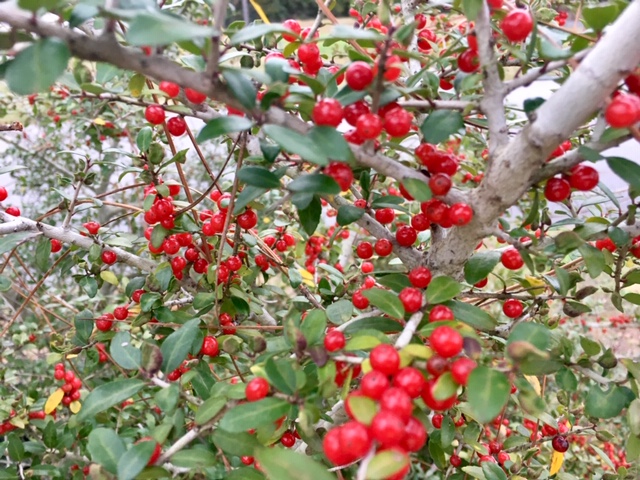
by Larry Williams | Dec 4, 2020
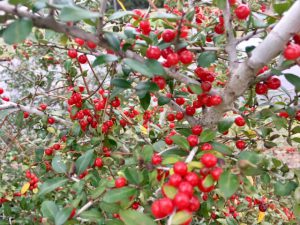
Native yaupon holly with bright red winter berries. Photo credit: Larry Williams
Holly plants are sometimes associated with Christmas. Their dark evergreen leaves and bright red berries fit right in with the Christmas Season. Some people intentionally plant hollies for the purpose of eventually using this desirable combination of green and red to create a more festive Holiday Season. But what if your hollies never produce berries?
The reason may be because you have a male plant. Male holly plants never produce berries. Holly plants are either male or female. The botanical term for this is dioecious. If a male plant is selected, it will produce male flowers and pollen but never set fruit.
One way to know that you’ve selected a female holly is by purchasing a plant with berries. However, you still will need a male plant nearby or no berries will be produced. Generally one male plant is adequate to insure pollination and good fruit set of berries on all female plants in a landscape. Your next-door neighbor may have a male holly plant that would serve as a pollinator for your hollies. Pollen produced by male flowers is transported by bees from distances up 2 miles. And because we are blessed with a number of native hollies in North Florida, chances are good that there will be a male holly within the appropriate distance in the wild to take care of the pollination.
The holly genus (Ilex) offers a terrific variety of plants from which to choose. Some horticulturists estimate that there are about 700 species worldwide. And there are a great number of cultivated varieties! When selecting a holly for your landscape, it is important to know that most dwarf holly cultivars don’t produce fruit as they are propagated by cuttings from male plants. Not all hollies have spiny leaves. For example, many of the Japanese hollies (Ilex crenata) have spineless leaves. There are hollies that grow tall, eventually making a tree. There are dwarf hollies that grow to only three to five feet in height. There are hollies with variegated leaves. And even though most hollies are evergreen, there are a few deciduous hollies that make nice additions to North Florida landscapes such as Ilex ambigua (Ambiguous Winterberry) and Ilex decidua (Possumhaw holly). Some hollies produce bright red berries but berry color varies from red, orange, yellow and even black or white, depending on variety. There are weeping forms available such as the weeping yaupon holly. There are those that have a very narrow, upright growth habit.
For more info on this diverse and interesting group of plants, visit the below UF/IFAS Extension webpage.
http://gardeningsolutions.ifas.ufl.edu/plants/trees-and-shrubs/shrubs/holly.html














